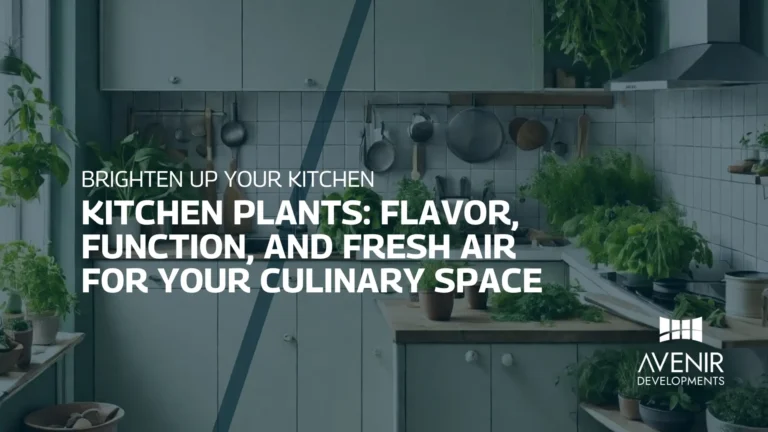Imagine reaching out your hand while chopping vegetables and snipping a sprig of fresh basil to add an aromatic touch to your dish. Or picture starting your day with a steaming cup of tea brewed with mint leaves grown right on your kitchen windowsill. Kitchen plants are more than just decorative elements; they’re a bridge between fresh ingredients and vibrant flavor, while purifying the air you breathe in your culinary haven.
This blog post from Avenir Developments, your trusted partner in creating beautiful and functional living spaces in Islamabad and beyond, dives deep into the world of kitchen plants. We’ll explore the history and benefits of incorporating greenery into your cooking area, delve into the latest trends, address common questions, and offer expert tips to help you cultivate a thriving kitchen herb garden.
A History of Flavor and Function: Kitchen Plants Through the Ages
The concept of kitchen plants has roots that stretch far back in history. Here’s a glimpse into their fascinating evolution:
- Ancient Origins: Evidence suggests that civilizations in Mesopotamia and Egypt cultivated herbs for both culinary and medicinal purposes as early as 5000 BC https://www.britannica.com/science/houseplant. These plants were likely grown close to dwellings, including kitchens, for easy access.
- The Rise of Herb Gardens: Fast forward to the medieval era, and we see the rise of dedicated herb gardens within monasteries and castle grounds https://www.britannica.com/art/herb-garden. These gardens not only provided herbs for cooking and healing, but also served an aesthetic purpose, often laid out in geometric patterns.
- Kitchen Gardens Take Center Stage: The 17th and 18th centuries saw a shift towards dedicated kitchen gardens, particularly in Europe and North America https://en.wikipedia.org/wiki/Kitchen_garden. These potager gardens, as they were called in France, were designed for both beauty and practicality, featuring an array of edible plants, including herbs, vegetables, and fruits, often located close to the kitchen for convenience.
- The Modern Kitchen Herb Garden: Today, kitchen plants have transcended their purely functional role. While their culinary value remains undeniable, they’re also appreciated for their aesthetic appeal, ability to purify the air, and connection to nature they bring to modern kitchens.
This historical journey highlights the enduring appeal of kitchen plants. From ancient civilizations to modern homes, these little green companions have consistently offered a fusion of flavor, function, and beauty.
Sprouting Trends: Kitchen Greenery Gains Momentum
The incorporation of kitchen plants is not just a nostalgic nod to the past; it’s a burgeoning trend with exciting developments:
- Urbanization and Indoor Living: As urban populations grow and living spaces shrink, people are seeking ways to reconnect with nature indoors. Kitchen plants offer a compact and convenient solution, adding a touch of greenery to even the most modest kitchens.
- Focus on Freshness and Sustainability: Consumers are increasingly interested in fresh, local, and sustainable ingredients. Growing your own herbs allows you to control the quality and eliminates the need for store-bought options, reducing your carbon footprint.
- Rise of the “Foodie” Culture: The explosion of culinary shows and a focus on gourmet experiences at home has fostered a desire for experimentation with flavor. Kitchen plants provide a readily available source of fresh herbs and ingredients to elevate any dish.
- Air-purifying Powerhouse: Studies have shown that certain kitchen plants can effectively remove common toxins and pollutants from indoor air https://www.ncbi.nlm.nih.gov/pmc/articles/PMC3400780/. This is particularly relevant in modern homes with tight seals, where air quality can be a concern.
- Vertical Gardens and Hydroponics: Space constraints are no longer a barrier. Vertical gardens and hydroponic systems allow for the cultivation of plants on walls or countertops, maximizing space utilization in compact kitchens.
These trends underscore the growing popularity of kitchen plants. From enhancing our connection with nature to promoting healthy living and culinary exploration, kitchen greenery is transforming the way we approach this vital space.
Frequently Asked Questions: Cultivating Your Kitchen Herb Garden
Kitchen plants offer a multitude of benefits, but navigating their care can sometimes feel daunting. Here, we address some commonly asked questions (FAQs) to equip you for success:
Q: What are some easy-care kitchen plants for beginners?
A: Excellent choices for beginners include herbs like basil, mint, rosemary, chives, and oregano. These plants are generally resilient and require minimal maintenance, thriving with moderate sunlight and regular watering.
Q: I have a kitchen with low light. Are there any plants that will do well?
A: Absolutely! Several low-light tolerant options flourish in kitchens. Snake plants, pothos, and philodendrons are all low-maintenance and appreciate indirect sunlight.
Q: What herbs can I grow on my windowsill?
A: A windowsill is a perfect spot for many culinary herbs! Thyme, parsley, chives, and mint are all well-suited to windowsill gardens, enjoying the extra sunlight they receive.
Q: How often should I water my kitchen plants?
A: Watering needs vary depending on the plant and environmental factors. A good rule of thumb is to water when the top inch of soil feels dry to the touch. Overwatering is a common mistake, so err on the side of underwatering.
Q: My kitchen gets quite hot while cooking. Will this harm my plants?
A: While some plants may not appreciate extreme heat, many herbs like rosemary and thyme can tolerate occasional spikes in temperature. Consider moving heat-sensitive plants away from the stovetop or oven while cooking.
Q: Can I harvest herbs grown indoors for cooking?
A: Absolutely! This is one of the biggest perks of having a kitchen herb garden. Snip leaves regularly to encourage bushier growth and enjoy the fresh flavor in your culinary creations.
By addressing these common concerns, we hope to empower you to confidently embark on your kitchen herb garden journey. Remember, even small steps towards incorporating greenery can significantly enhance your culinary space.
Expert Tips for Thriving Kitchen Plants: From Seedling to Harvest
Having explored the history, trends, and FAQs surrounding kitchen plants, let’s delve into some practical advice to cultivate a flourishing herb garden in your culinary haven.
Choosing the Right Plants
- Consider your cooking style: Select herbs you frequently use in your dishes. Popular choices include basil, oregano, thyme, rosemary, and parsley.
- Light conditions: Assess the natural light availability in your kitchen. Opt for low-light tolerant plants like pothos or snake plants if your kitchen receives minimal sunlight.
- Space constraints: Be realistic about available space. Vertical gardens or hanging planters are space-saving solutions for compact kitchens.
Planting and Care:
- Suitable Pots: Select pots with drainage holes to prevent waterlogging. Consider using terracotta pots for their breathability.
- Potting Mix: Use a well-draining potting mix specifically formulated for indoor plants.
- Watering Wisely: Water deeply when the top inch of soil feels dry. Avoid overwatering, which can lead to root rot.
- Light Matters: Provide adequate light based on the plant’s needs. Most herbs prefer bright, indirect sunlight.
- Feeding Time: Fertilize your plants occasionally during the growing season with a balanced liquid fertilizer diluted according to package instructions.
Location, Location, Location
- Heat and Ventilation: Keep your plants away from direct heat sources like stoves and ovens. Ensure good air circulation to prevent fungal diseases.
- Grouping Plants: Group plants with similar light and watering needs together for easier care.
Harvesting and Maintenance
- Snip with Care: Harvest leaves regularly to encourage bushier growth. Use sharp shears or scissors to avoid damaging the plant.
- Regular Pruning: Prune occasionally to maintain a compact shape and remove any dead or diseased leaves.
- Repotting: As your plants mature, they may need to be repotted into larger containers to accommodate root growth.
By following these expert tips, you can create a thriving kitchen herb garden that not only enhances your culinary creations but also adds a touch of life and vibrancy to your cooking space. Remember, a little planning and consistent care go a long way in ensuring your plants flourish and bring you joy for years to come.
Cultivating Flavor, Function, and Freshness in Your Kitchen
Kitchen plants are more than just decorative elements; they’re an embodiment of flavor, function, and fresh air. They bridge the gap between nature and your culinary haven, offering a constant source of fresh ingredients, purifying the air you breathe, and adding a touch of beauty to your cooking space.
Throughout this blog post, we’ve explored the rich history of kitchen plants, delved into the latest trends, addressed common concerns, and shared expert tips to empower you to cultivate your own thriving herb garden.
Here’s a quick recap of the benefits you can reap by incorporating kitchen plants:
- Fresh, Flavorful Ingredients: Enjoy the unmatched taste and aroma of homegrown herbs in your cooking.
- Enhanced Air Quality: Certain plants act as natural air purifiers, removing toxins and pollutants from your kitchen environment.
- A Connection to Nature: Bring a touch of greenery indoors and cultivate a sense of peace and well-being in your kitchen.
- Aesthetics and Ambiance: Liven up your kitchen with vibrant plants and create a more inviting atmosphere.
- A Sense of Accomplishment: Experience the satisfaction of nurturing and harvesting your own herbs.
Ready to embark on your kitchen herb garden journey? Avenir Developments, your trusted partner in creating beautiful and functional living spaces, is here to help. We offer a variety of consultations and design services to optimize your kitchen for both functionality and aesthetics.
Contact us today on WhatsApp or call +923001101103 to discuss how we can transform your kitchen into a space that inspires culinary creativity and fosters a connection with nature.
We hope this blog post has armed you with the knowledge and confidence to cultivate a thriving kitchen herb garden. Remember, even a single well-cared-for plant can significantly enhance your culinary space. So, happy planting, and happy cooking!






